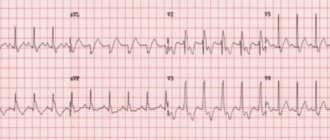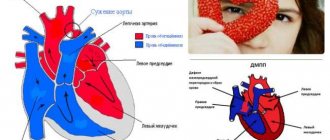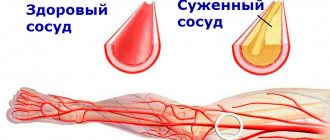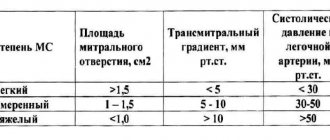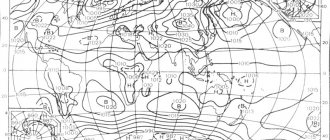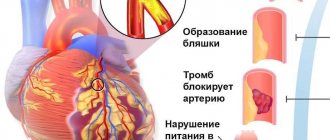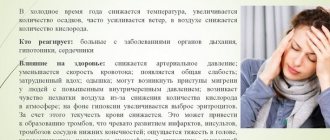Pressure in the cavities of the heart
Since the movement of blood in the cavities of the heart, as in the entire circulatory system, is determined by the difference in pressure along the entire path of blood movement, it is necessary to consider how the pressure in the atria and ventricles changes during systole and diastole.
For the first time, measurements of pressure in the cavities of the heart , as well as in the aorta and pulmonary artery in experiments on large animals (horses and dogs) were carried out in 1861 by Chauveau and Marey. For this purpose, they inserted a thin metal tube - a probe - through the jugular vein opened in the neck, pushing it to the vena cava, and then to the right atrium, right ventricle or pulmonary artery. The probe was connected to a device for recording pressure. If it was necessary to determine pressure fluctuations in the left half of the heart, the probe was inserted into the left ventricle, through the left carotid artery and the aortic arch.
| In recent years, measurements of intracardiac pressure have also been carried out in humans for certain heart diseases, when these measurements are necessary for diagnosis, i.e., to determine the nature of the heart disease. For this purpose, a thin elastic hollow probe, a catheter, is inserted into the central end of the opened brachial vein and pushed towards the vena cava and further to the right atrium, ventricle or pulmonary artery (Fig. 24). A probe is inserted into the aorta or left ventricle through the brachial artery. Pressure in the cavities of the heart and large vessels is also measured by puncture, that is, the chest is pierced and a hollow needle is inserted into one of the atria or one of the ventricles, into the aorta or into the pulmonary artery. A zogd (or needle) filled with an anticoagulant solution, inserted into the heart cavity or into a large vessel, is connected to a sensitive and inertia-free electric manometer and pressure fluctuations are recorded in this way. Rice. 24. The path along which the catheter passes from the ulnar vein to the right heart and pulmonary artery (A), and a radiograph of the human chest with a catheter inserted into the pulmonary artery (B) (according to E. N. Meshalkin) |
Fluctuations in atrial pressure are relatively small. At the height of atrial systole, the pressure in them is 5-8 mm Hg. Art. During atrial diastole, the pressure in them drops to 0, then, starting from the middle of ventricular systole, it slowly increases due to the filling of the atrium cavity with blood flowing from the veins (Fig. 25). When ventricular systole closes and the atrioventricular valves open, the pressure in the atria drops again, because blood from them freely passes into the ventricles. 0.1 seconds before the onset of ventricular systole, atrial systole begins, as a result of which some additional filling of the ventricles with blood occurs. This additional filling is not, however, important, since most of the blood filling the ventricle has already entered it in the first period of ventricular diastole.
The level of pressure in the atria during diastole depends on the phase of breathing. During inspiration, the pressure in the atria at the beginning of their diastole becomes negative, i.e., below atmospheric. The reason for this decrease in pressure is that at the height of inspiration, the negative pressure in the chest cavity increases. Due to the decrease in pressure in the atria at the height of inspiration, the flow of blood from the veins to them increases. During exhalation, the negative pressure in the thoracic cavity decreases and the pressure in the atria at the beginning of their diastole becomes close to 0.
| Ventricular systole begins after the end of atrial systole. The contraction wave, gradually spreading throughout the myocardium, does not immediately cover the entire mass of the ventricular muscles; part of the muscle fibers contracts, as a result of which the other part, which has not yet contracted, does not change. Therefore, the shape of the ventricles changes, but the pressure does not change. This period of ventricular systole, when the wave of excitation and contraction propagates throughout the myocardium, is called the phase of asynchronous contraction, or the period of change in the shape of the ventricles. It lasts 0.05 seconds. After all the muscle fibers of the ventricles are covered by contraction, the blood pressure in the ventricular cavity begins to increase, which causes the closure of the atrioventricular valves. The semilunar valves are also closed at this time, because the pressure in the ventricles is still lower than in the aorta and pulmonary artery. Therefore, for a short period of time - 0.03 seconds - the muscles of the ventricles tense, but their volume changes (since the blood in the ventricles, like any liquid, is practically incompressible) until the pressure in the ventricle exceeds the pressure in the aorta and pulmonary artery and until the semilunar valves open under the influence of blood pressure. The period of contraction with the valves closed is called the isometric contraction phase (isometric is a muscle contraction in which the muscle fibers develop tension but do not shorten). The phases of asynchronous and isometric contractions are together called the period of ventricular tension (2 and 3 in Fig. 25). Rice. 25. Schematic curves of changes in pressure in the right (A) and left (B) parts of the heart, heart sounds (C), ventricular volume (D) and electrocardiogram (E). |
| When, as a result of isometric contraction, the pressure in the ventricles becomes higher than the pressure in the aorta and pulmonary artery, the valves of the aorta and pulmonary artery open, the phase of expulsion of blood from the ventricles begins and blood flows from the ventricles into the aorta and pulmonary artery (4 in Fig. 25). In humans, blood expulsion, in other words, systolic ejection into the aorta, i.e., into the systemic circulation, begins when the pressure in the left ventricle reaches 65-75 mm Hg. Art., and the expulsion of blood into the pulmonary artery, i.e., into the pulmonary circulation, begins when the blood pressure in the right ventricle reaches 5-12 mm Hg. Art. Rice. 26. Normal pressure values in the right atrium, right ventricle, pulmonary artery, left atrium, left ventricle, aorta (according to Luizada and Liu). |
At the first moment of the ejection phase, blood pressure in the ventricles increases as steeply as before the opening of the semilunar valves (rapid ejection phase - 0.10-0.12 seconds). As the amount of blood in the ventricles decreases and the inflow of blood into the aorta and pulmonary artery becomes less than the outflow from them, the increase in pressure stops and the pressure begins to fall towards the end of systole (phase of slow expulsion of blood - 0.10-0.15 seconds) .
The maximum level of pressure at the height of systole under normal physiological conditions reaches 115-125 mm Hg in the left ventricle. Art., and in the right ventricle 25-30 mm. The greater height of blood pressure created by the left ventricle than the right is due to the greater power of its muscles. This is due to the fact that the left ventricle has to overcome greater resistance to blood flow in the vessels of the systemic circulation. Fluctuations in pressure in the aorta and pulmonary artery during the period of expulsion of blood from the ventricles follow changes in pressure in the corresponding ventricle: in the aorta at systole the pressure is 110-125 mm, and in the pulmonary artery - 25-30 mm (Fig. 26).
Following the ejection phase, ventricular diastole occurs. They begin to relax, so the pressure in the aorta becomes higher than in the ventricle, and the semilunar valves close. The time from the beginning of ventricular relaxation to the closing of the semilunar valves is called the protodiastolic period, which lasts 0.04 seconds (5 in Fig. 25). Then, for some time (about 0.08 seconds), the ventricles continue to relax with both the atrioventricular and semilunar valves closed, until the pressure in the ventricles drops below that in the atria, which by this time are already filled with blood. This period of systole is designated as the phase of isometric relaxation, or the phase of tension reduction (6 in Fig. 25). Its duration is on average 0.08 seconds. Following this, the leaflet valves open and blood from the atrium begins to fill the ventricles.
The flow of blood into the ventricles is rapid at first, since the pressure in them after their relaxation drops to 0 (the rapid filling phase, lasting 0.08 seconds - 7 in Fig. 25). As the ventricles fill, the pressure in them increases slightly and filling slows down (slow filling phase, lasting 0.16 seconds - 8 in Fig. 25). At the end of ventricular diastole, atrial systole occurs with a duration of 0.1 seconds (the ventricular filling phase caused by atrial systole, or presystole - 1 in Fig. 25).
During ventricular diastole, blood pressure in the aorta and pulmonary artery gradually decreases as blood outflows from them, and by the end of diastole it is 65-75 mm Hg in the aorta, and 5-10 mm Hg in the pulmonary artery. Art. Since this end-diastolic pressure is higher than the pressure in the ventricles, the semilunar valves remain closed until the pressure in the ventricles during their contraction exceeds the level of pressure in the large arterial trunks.
The sequence of individual phases of the ventricular activity cycle can be presented as follows:
The given indicators of the duration of systole and diastole and their phases represent the average data observed at a heart rate of 75 per minute. With a more frequent or slower heart rate, the duration of the phases changes. As the rhythm increases, diastole is significantly shortened, mainly due to a decrease in the duration of the slow filling phase. Systole is shortened relatively less due to a decrease in the time of slow expulsion of blood from the ventricles. When the heart slows down, opposite changes occur in the duration of the ejection and filling phases of the ventricles.
Pulse and pressure
September 2, 2016
We all had our pulse and blood pressure taken. We know it doesn't hurt, but why are these indicators measured?
Whenever you visit a doctor or call an ambulance to your home, as a mandatory initial procedure, a specialist measures your pulse and blood pressure. But why is it so important to know these seemingly simple meanings of your body? And what do these numbers even mean? What are the reasons for high or low blood pressure? What are the dangers of an accelerated or, conversely, slowed heartbeat? To begin with, these two values show how the main part of a person works - the cardiovascular system. It is important because it is the blood that supplies oxygen and nutrients to all the cells of our body. Therefore, it is simply necessary to know when your so-called “river” system develops deviations in the form of contamination and decreased elasticity of the veins. So what pressure can be considered normal? Under what circumstances should you contact a specialist? Now let's look at all these aspects. Pulse. It, like pressure, has an extremely variable value. You've probably noticed how hard and fast your heart beats after exercise, and how uniform your heartbeat is at rest. There is no ideal value that everyone should strive for. In children, the heart contracts at a much higher rate than in an adult. On average, a reading of 65 - 75 beats per minute is considered normal. Therefore, when this value falls or rises by more than 20, it is already considered a deviation requiring prevention or treatment. For a healthy person, the rhythm of the heartbeat is also important. If the heart beats irregularly, it is called arrhythmia and is an extremely dangerous heart disease. A trained person involved in sports has a lower heart rate. This happens because the heart pumps more blood with each beat. Pressure. As with the pulse, everything is just as ambiguous here. The values depend on age, gender, physical activity and psycho-emotional situation. And everyone’s body is different, so the indicators may differ. We will talk about averages. When measuring blood pressure, we always hear two numbers, which are called the upper (systolic) and lower (diastolic) values. The first shows the force with which the blood presses on the walls of blood vessels during maximum contraction of the heart, and the second, on the contrary, in a resting situation. The difference between them is called pressure. On average, this difference should exceed 20 mmHg. Art. Low blood pressure leads to tachycardia, and high blood pressure is an indicator of atherosclerosis, heart failure, anemia, etc. It often happens to athletes that their average value is low, about 100/60, and yet they feel great. With age, the value increases. A newly born child has a normal measurement of 80/50 mm. rt. Art., and by the year of life it reaches 96/66 mm. rt. Art. In this regard, up to five years of age there is no difference between the sexes. At the age of 18-20 in men, 120/80 mm becomes satisfactory. rt. Art., and for girls 115/70 mm. rt. Art. By the age of seventy, the figures increase to 145/80-85 in the stronger sex and 155/85 mm. rt. Art. among representatives of the fair half of humanity. There is a concept called “working pressure”, at which the values may differ from the average, but the body still feels good. Therefore, try to always monitor your constant indicators. Moreover, with current technologies, this is available to everyone, just buy a tonometer. If you see that your cardiovascular system indicators are close to critical, immediately take care of your health: go to the doctor, start eating right and exercise. Remember that prevention is always easier and better than cure.
Tags:
- Prevention
- Pulse
- Arterial pressure
To leave a comment you must be an authorized user
